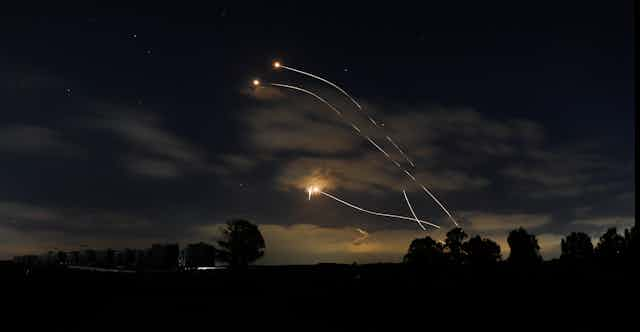Gaza militants have launched their “Sword of Jerusalem” rocket war with Israel by firing a symbolic salvo at Jerusalem and bigger ones elsewhere. Israel’s “Guardian of the Walls” operation responded with Iron Dome interceptors at home and airstrikes in Gaza.
As someone who’s researched Israeli missile defence systems for several years, the situation initially seemed to me like a repeat of their 2014 conflict, which showcased Israel’s advanced defences. But militants in Gaza have enhanced their rocket technology and tactics. That’s reminiscent of 2008, when Israel was more vulnerable to rockets and waged a three-week military offensive against Gaza.

According to the Israel Defense Forces, roughly 3,100 rockets have been fired from Gaza. That’s about as many as during the seven-week battle in 2014. (All rocket numbers in this article were reported by the Israel Defense Forces or Israel Security Agency. There is no way to independently verify most of them.)
Israeli news reports say they’ve caused 10 civilian deaths and more than 564 injuries, while Israeli countermeasures have killed almost 200 Palestinians and resulted in scenes of carnage and devastation.

The counts have risen so quickly because Gaza militants have improved their rockets and their usage of them.
Improved rocketry
The most noticeable change this year is larger quantities. Gaza militants fired 470 rockets during the first 24 hours and have averaged 408 per day. Those numbers easily beat the one-day maximums of 316 in 2012 and 192 in 2014.
The firing is also better co-ordinated. Rather than launching many small attacks spread across the day, they’ve unleashed larger salvos of up to 137 rockets within five minutes. That’s much improved, though still far slower than regular army artillery units.
Accuracy has improved, too. About 50 per cent of the rockets arriving over Israel have threatened populated areas. That’s up from 22 per cent in 2012 and 18 per cent in 2014. Fewer rockets land in empty fields after missing their targets.
Larger, longer-range rockets are also more common now. During previous conflicts, Israel’s southern cities endured most of the fire. This time, Tel Aviv, in central Israel more than 55 kilometres from Gaza’s border, is routinely targeted.
Rocket reliability, however, has dropped. About 15 per cent have failed at launch, versus under 10 per cent during previous conflicts.
Destructive impact
The improved technology and tactics make barrages more destructive. My calculations suggest at least 134 rockets have hit populated areas.
During the first four days of this conflict, one Israeli died for every 206 rockets reaching the country. That approaches the one-per-204 rate of 2008, when Israel’s defences were weaker. By comparison, it took 270 rockets to kill a civilian in 2012 and 1,429 in 2014.
The injury rate, about one for every three rockets arriving overhead, also resembles 2008. And many buildings have been damaged.

These results imply that shock-and-awe destruction is the 2021 strategy of Gaza militants. By comparison, the 2014 operation mostly featured economic attrition. Israel suffered relatively few civilian casualties but heavy financial costs from the prolonged disruption.
Both then and now, Israel has responded with several countermeasures.
Blocking (many) rockets
Iron Dome interceptors provide the best-known defence. Israel claims the systems intercepted 1,210 rockets last week, or 90 per cent of the rockets they engaged. That’s about the percentage they achieved in 2014, too, though perhaps not in 2012.

Are they always achieving it now?
With bigger barrages and greater accuracy, more rockets are arriving together above each target. That means there’s more risk the interceptors will become overloaded and let some rockets through.
Suppose the systems sometimes block “only” 80 per cent of rockets. That’s still impressive. But it means the portion penetrating then doubles from 10 to 20 per cent, causing twice the destruction.
My research seven years ago analyzed this tactic. It showed that high-performing interceptors can seem “fragile” — once their capacity is exceeded, damage on the ground soars.
That research also studied the idea of firing directly at interceptor systems to disable them. Sure enough, one barrage recently made such an attempt. That was likely a waste of ammo, as their rockets aren’t accurate enough yet for such small targets.
Ironically, one Iron Dome system was briefly disabled two days earlier by an equipment malfunction. That let some extra rockets through.
Israel also has extensive warning systems and bomb shelters. Those prevent as many casualties as interceptors do, but don’t stop property damage.
Read more: Israeli rocket experience shows bomb shelters matter as much as interceptors
Airstrikes are another Israeli countermeasure. Its aircraft began bombing rocket stockpiles and launchers last week, followed by production sites and other targets.
But while its bombers can destroy rocket stockpiles and workshops, they don’t have much immediate effect on firing rates. My analysis of previous operations found that airstrikes didn’t decrease daily fire rates; only ground assaults did that
Collateral damage is another problem. Bombs have damaged or completely destroyed many buildings. And almost 200 Palestinian militants and civilians have died so far.

What next?
Gaza’s 14,000-rocket arsenal could support short-range barrages for months.
But it will likely run out of long-range rockets sooner, making a truce look more attractive. Israel might favour a truce soon, too, as it runs out of meaningful airstrike targets.
Let’s hope that truce happens soon. The alternatives are a prolonged war of aerial attrition, or a costly ground battle in Gaza.

